
SilverStone Sugo SG10 - Interior
Three rear thumbscrews and a regular screw on the side hold the main n-shaped lid in place, although the lid doesn't extend fully down the left side of the case as there's a separate panel for the side fans. This second panel is held in place with a pair of thumbscrews and a normal screw beneath the chassis and, like the lid, slides off easily once these are removed.Removing the lid reveals most prominently the large AP181 fan mounted to the roof and neatly tied to its fan controller, which thankfully doesn't require an extra power connection. SilverStone also supplies an adaptor to power the three default fans with a single molex connection, which saves on cabling and thus on space. Just ahead of the 180mm fan is the slimline optical bay, which could be used to stash a few cables if not in use.
The motherboard tray and expansion card slots are in their regular ATX-style locations. The tray features a massive cutout for CPU coolers, which is handy as the case is able to house tower coolers up to 165mm tall (more than many ATX cases). The tray also includes pre-built motherboard standoffs, and the covers for the expansion slots are screwed into place and thus reusable.
Where the layout differs most dramatically from the norm is the PSU location, which sits at the front of the case. The space below the PSU is what allows the case to support graphics cards that are almost as long as the case itself, and it can also be used for storing cables when using shorter cards. The bracket for the PSU doesn't feature any padding, but a couple of screws allow you to slide it out, which also helps with getting larger motherboards into the chassis. It's also designed such that your PSU intake fan can face into or out of the case, but the latter is naturally the better choice.
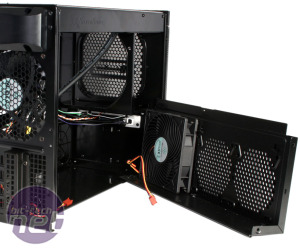
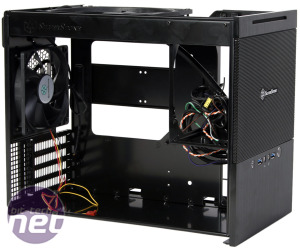
Click to enlarge - There's a separate panel for the side fans, and a removable PSU bracket at the front
As with the SG09, the rotation of our PSU's AC input socket meant that the internal cable for it in the SG10 unavoidably pushed against the 120mm side intake fan when we reattached the panels. The effect is admittedly only small, but it's enough to break the straight edge of the case, so users with sockets in the same rotation would need to remove the 120mm fan or replace it with a smaller model to avoid this.
The SG10 is also said to support ATX PSUs up to 180mm in length, but 160mm is recommended by SilverStone. It specifically recommends its own Strider PSUs and its short cable set, and though we can't give our own outright recommendation to those products, the benefits of using them in our SG09 build were certainly obvious. Essentially, the more modular your PSU is and the shorter its cables, the less hassle building in the cramped confines of the SG10 is going to be, especially if you're using lots of hardware.

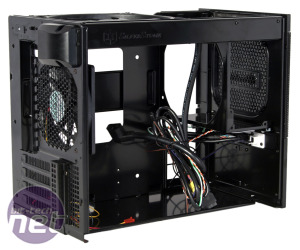
Click to enlarge - Internal drives are mounted to the back of the motherboard, freeing up space in the main area
Internal drives are installed to mounting plates that are themselves attached to the rear of the motherboard tray. Larger 3.5-inch models are secured to the metal bar that lies across the CPU cutout and features rubberised screw holes to dampen vibrations, while SSDs are installed between a pair of plastic brackets below this. It's a bit of a hassle having to remove the necessary plates before installing the drive and then replacing them, but it's also a fair trade given the case's dimensions. It also ensures you won't need to remove the motherboard to access the drives, which would be a far greater hassle.
A few sensibly placed holes and cutouts around the motherboard tray are provided for cable management. There's a surprisingly large amount of space behind the motherboard for stashing unsightly cables too, but we still found it preferable to cram the majority of them into the front of the main cavity. That said, users with longer graphics cards as well as those with extra fans or drives will have less available space for hiding cables. Therefore, while we encountered no real issues tidying our wires (which is still impressive for so small a case), building a fully equipped system into the SG10 would be a challenging project to say the least.

MSI MPG Velox 100R Chassis Review
October 14 2021 | 15:04

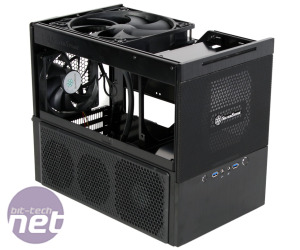
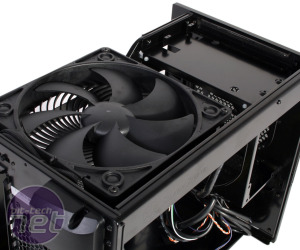
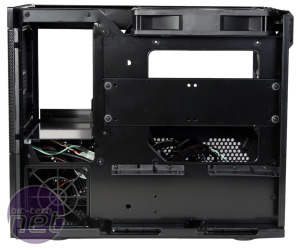
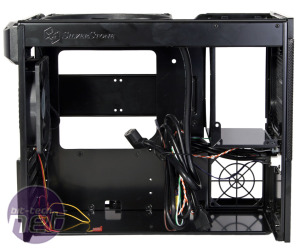







Want to comment? Please log in.